Apple Inc exported more than US$2.5 billion of iPhones from India from April to last month, nearly twice the previous fiscal year’s total, underscoring how the US tech giant is accelerating a shift from China with geopolitical tensions on the rise.
Foxconn Technology Group (富士康科技集團), known as Hon Hai Precision Industry Co (鴻海精密) in Taiwan, and Wistron Corp (緯創) had each shipped more than US$1 billion of Apple’s marquee devices abroad in the first nine months of the fiscal year ending in March, people familiar with the matter said.
Pegatron Corp (和碩), another major contract manufacturer for Apple, is on track to move about US$500 million of the gadgets overseas by the end of this month, the people said.
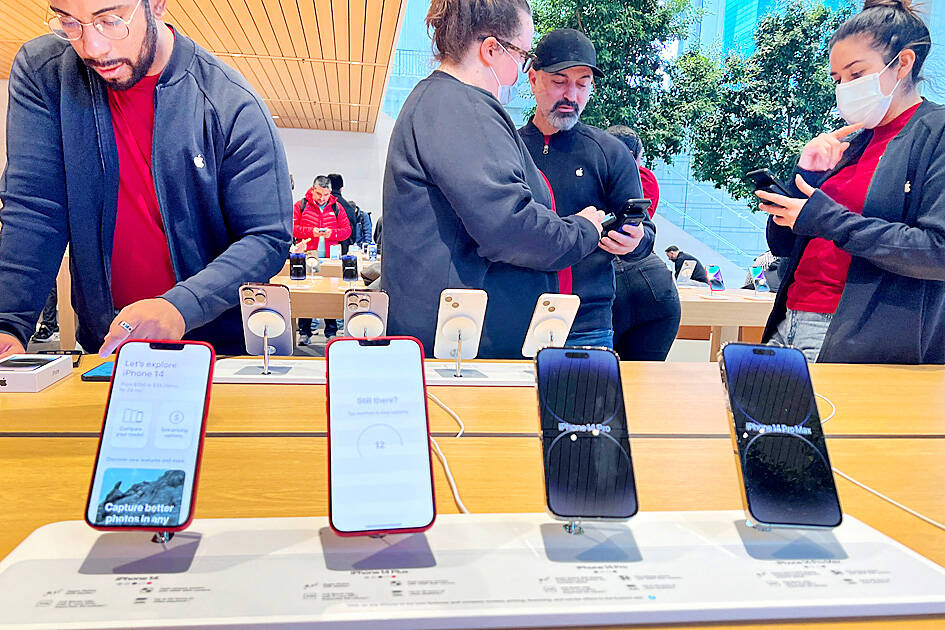
Photo: AFP
Apple’s rapidly growing export numbers illustrate how it is ramping up operations outside of China, where chaos at Foxconn’s main plant in Zhengzhou exposed vulnerabilities in the Cupertino, California-headquartered company’s supply chain and forced it to trim output estimates.
That compounded a broader problem with evaporating demand for electronics as consumers weigh the risks of a global recession.
Apple, the world’s most valuable company, began assembling its latest iPhone models in India only last year, a significant break from its practice of reserving much of that for giant Chinese factories run by its main Taiwanese assemblers including Foxconn.
While India makes up just a fraction of iPhone output, rising exports bode well for Indian Prime Minister Narendra Modi’s plan to make the nation an alternative to China as factory to the world.
Foxconn, Apple’s largest supplier, began building facilities in India more than five years ago in anticipation of a need to extend its geographic range.
One selling point is a raft of new government incentives, a cornerstone of Modi’s drive to make India an electronics manufacturing hub. Foxconn has won 3.6 billion rupees (US$43.7 million) of benefits in the first year of the so-called production-linked incentives scheme, while Wistron’s claims are being processed, the people said.
Apple’s contract manufacturers make iPhones at plants in southern India, but production in the nation is just beginning. About 3 million of the devices were made in India in 2021, compared with 230 million in China, according to Bloomberg Intelligence estimates.
Foxconn began making the iPhone 14 in India a few months ago — sooner than anticipated — after a surprisingly smooth production rollout that slashed the lag between Chinese and Indian output from months to weeks.
Apple’s three Taiwanese partners assemble iPhones 11 to 14 in India, but moving out of China, where Apple has built a deep supply chain for close to two decades, is not easy. A Bloomberg Intelligence analysis estimated it would take about eight years to move just 10 percent of Apple’s production capacity out of China, where about 98 percent of the company’s iPhones are being made.
India tracks production and exports of all smartphone makers who enjoy financial incentives.
Beyond smartphones, the nation is drawing up plans to boost financial incentives for tablet and laptop makers, hoping to woo Apple to make everything from earphones to MacBooks locally.
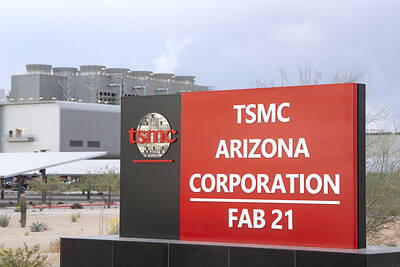
Taiwan Semiconductor Manufacturing Co (TSMC, 台積電), the world’s biggest contract chipmaker, booked its first-ever profit from its Arizona subsidiary in the first half of this year, four years after operations began, a company financial statement showed. Wholly owned by TSMC, the Arizona unit contributed NT$4.52 billion (US$150.1 million) in net profit, compared with a loss of NT$4.34 billion a year earlier, the statement showed. The company attributed the turnaround to strong market demand and high factory utilization. The Arizona unit counts Apple Inc, Nvidia Corp and Advanced Micro Devices Inc among its major customers. The firm’s first fab in Arizona began high-volume production
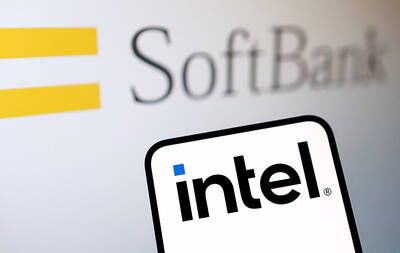
VOTE OF CONFIDENCE: The Japanese company is adding Intel to an investment portfolio that includes artificial intelligence linchpins Nvidia Corp and TSMC Softbank Group Corp agreed to buy US$2 billion of Intel Corp stock, a surprise deal to shore up a struggling US name while boosting its own chip ambitions. The Japanese company, which is adding Intel to an investment portfolio that includes artificial intelligence (AI) linchpins Nvidia Corp and Taiwan Semiconductor Manufacturing Co (TSMC, 台積電), is to pay US$23 a share — a small discount to Intel’s last close. Shares of the US chipmaker, which would issue new stock to Softbank, surged more than 5 percent in after-hours trading. Softbank’s stock fell as much as 5.4 percent on Tuesday in Tokyo, its
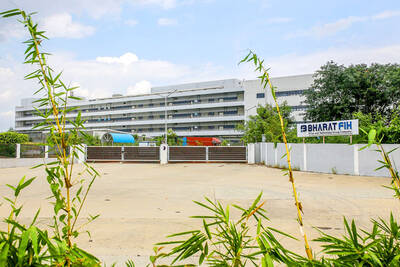
SETBACK: Apple’s India iPhone push has been disrupted after Foxconn recalled hundreds of Chinese engineers, amid Beijing’s attempts to curb tech transfers Apple Inc assembly partner Hon Hai Precision Industry Co (鴻海精密), also known internationally as Foxconn Technology Group (富士康科技集團), has recalled about 300 Chinese engineers from a factory in India, the latest setback for the iPhone maker’s push to rapidly expand in the country. The extraction of Chinese workers from the factory of Yuzhan Technology (India) Private Ltd, a Hon Hai component unit, in southern Tamil Nadu state, is the second such move in a few months. The company has started flying in Taiwanese engineers to replace staff leaving, people familiar with the matter said, asking not to be named, as the
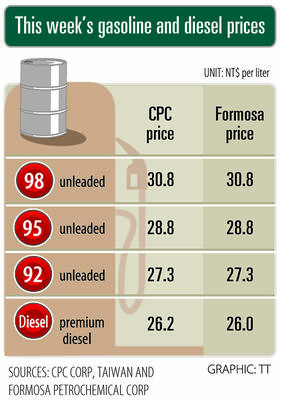
The prices of gasoline and diesel at domestic fuel stations are to rise NT$0.1 and NT$0.4 per liter this week respectively, after international crude oil prices rose last week, CPC Corp, Taiwan (台灣中油) and Formosa Petrochemical Corp (台塑石化) announced yesterday. Effective today, gasoline prices at CPC and Formosa stations are to rise to NT$27.3, NT$28.8 and NT$30.8 per liter for 92, 95 and 98-octane unleaded gasoline respectively, the companies said in separate statements. The price of premium diesel is to rise to NT$26.2 per liter at CPC stations and NT$26 at Formosa pumps, they said. The announcements came after international crude oil prices